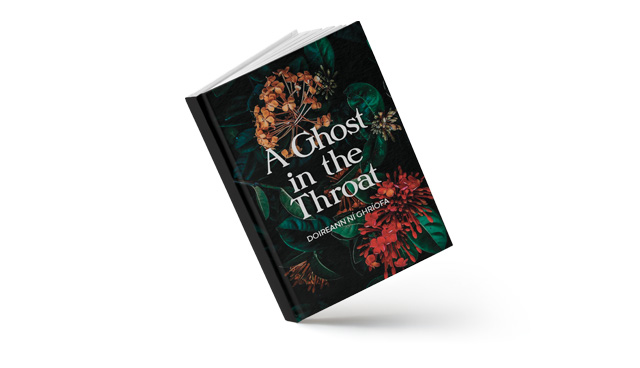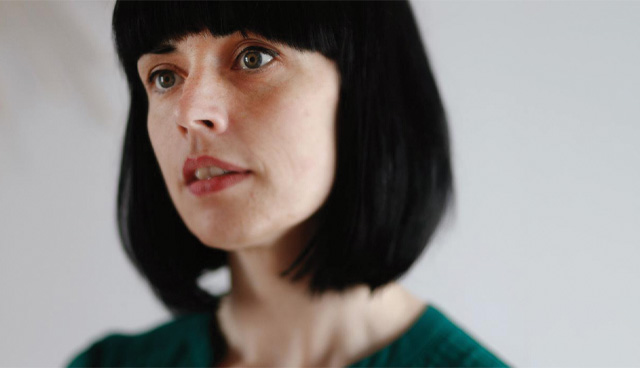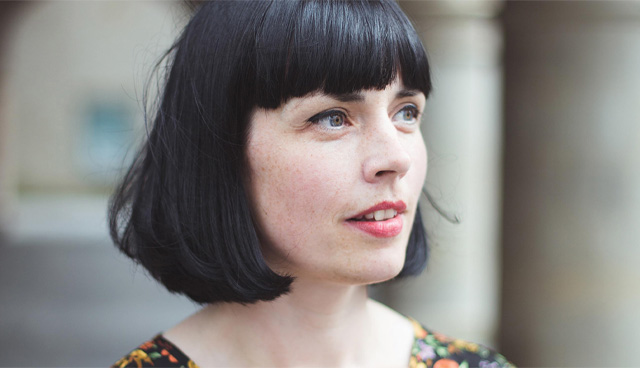Doireann Ní Ghríofa: A Ghost in the Throat

Clare native Doireann Ní Ghríofa is one of Ireland’s most celebrated contemporary poets. Her bilingual poetry has won prestigious awards at home and abroad, including the Rooney Prize for Irish Literature in 2016. She talks to Odrán Waldron, in both English and Irish, about her prose debut, A Ghost in the Throat, which explores the famous “Caoineadh Airt Uí Laoghaire” and its writer, Eibhlín Dubh Ní Chonaill.
Tosnaíonn Ní Ghríofa ag labhairt faoina caidreamh leis an nGaeilge agus miníonn sí an áit ina d’fhoghlaim sí an teanga. “Táim an-buíoch do mo thuismitheoirí gur chuireadar i nGaelscoil mé nuair a bhí mé ceithre bliana d’aois,” deir sí. “Is dócha nuair atáimid ag breathnú siar ar ár saol féin, go mbíonn sé soléir, na nóiméid bheaga sin ina gcuirtear ar bhóithrín thú. Domsa agus mé ceithre bliana d’aois, thosaigh mo thuismitheoirí i nGaelscoil mé agus thosaigh mé ar bhóithrín na Gaelainne.
“Ní raibh Gaelainn sa bhaile againn, is Béarla amháin a bhí againn. Tá beagán Gaeilge ag m’athair agus Gaeilge líofa go leor ag mo Mham ach Béarla amháin a bhí sa bhaile againn. Gan an cinneadh sin, gach seans nach mbeadh Gaeilge agam. Táim an-sásta gur cuirtear chuig an Ghaelscoil sin mé, Gaelscoil Mhichíl Ciosóg in Inis, Contae an Chláir. Is dóigh liom nuair a smaoiním ar an gcaoi go gcuirtear gasúr go Gaelscoil, go bhfuil sé cosúil le croí beag eile a chur ag preabadh ionat agus bíonn sé ag preabadh ionat i gcónaí. Tá mo chuid pháistí i nGaelscoil anois iad féin. Tá árd-mheas agam ar an gcóras sin.”
Ag breathnú siar ar a saol agus ar a cuid ama caite aici sa Ghaeloideachas, ceapann Ní Ghríofa gur chuir an turas isteach go Inis gach lá ar bhealach na scríbhneoireachta í. “Ní raibh aithne ceart agam ar na páistí eile sa bhaile. Is cinéal áit iargúlta faoin tuath i gContae an Chláir í agus bhí mé ag freastail ar Ghaelscoil in Inis a bhí 15 nóiméad uainn,” deir sí. “D’fhág sin nár chuir me aithne ar na páistí a bhí thart timpeall orainn agus bhí sé sin cinéal uaigneach ar shlí. Cé go raibh mé ag dul i ngleic leis an teanga, bhí uaigneas i gceist freisin agus nuair a bhí mé níos óige, shíl mé gur droch rud a bhí ann ach anois ag breathnú siar, déarfainn gur rud maith é agus nach mbéinn i mo scríbhneoir murach an t-éispéireas sin.”
Ag éisteacht léi, tá sé soléir nach n-athródh sí aon rud faoin uaigneas sin dá mbeadh seans aici agus go dtuigeann sí gur thug an t-uaigneas féirín di atá de dhith ag gach scríbhneoir, an súil a fhaigheann tú nuair a bhraithníonn tú taobh amuigh d’imeachtaí.
“Is dóigh liom go mbíonn saol mar sin ag gach duine a dhéanann an cinneadh a bheith ina scríbhneoir, go mothaíonn siad as áit, ar an dtaobh amuigh agus go mbíonn sé sin i gceist le nach mór gach scríbhneoir. Níl sé compórdach nuair a mhothaíonn tú féin go bhfuil tú ar an dtaobh amuigh. Tugann sé cinéal lionsa ar leith duit le breathnú ar an saol. Ní mhothaíonn tú go bhfuil tú istigh insan saol. Tá coiscéim tógtha siar agat agus tá tú taobh amuigh de,” deir sí.

Tá A Ghost in the Throat bainte leis an gcaidreamh atá ag Ní Ghríofa le “Caoineadh Airt Uí Laoghaire”, an caoineadh cálúil a scríobh Eibhlín Dubh Ní Chonaill insan 18ú aois tar éis dúnmharú a fear chéile, Art Ó Laoghaire. Leanann leabhar Ní Ghríofa agus í i mbun aire a thabhairt do thriúr páistí, ag iompar an cheathrú páiste agus ag iarraidh a haistriúchán féin a dhéanamh ar an gcaoineadh. Chuir sí béim ar na mothúcháin atá fíor beo insan leagan Gaeilge, ar shaol Eibhlín Dubh mar bhean agus ar an téacs mar théacs baininscineach.
“Tá an-spéis agam insan caoineadh mar fhoirm liteartha agus tá an t-ádh linn go bhfuil an oiread taighde déanta air,” a deir Ní Ghríofa. “Ní scoláire mise agus táim ag foghlaim faoi an t-am ar fad. Seans iontach a bhí insan leabhar seo le diriú isteach ar an bhfoirm liteartha sin agus tuilleadh eolais a fhoghlaim faoi. Bhain mé an-sult as sin, ag breathnú go cúramach, ag déanamh dianscagadh ar an bhfoirm, go háirithe de bhrí go raibh sé mar fhoirm bhaineann don oiread ama sin. Táim fós ag foghlaim mar gheall ar an gcaoineadh.
“Ó thaobh ‘Caoineadh Airt Uí Laoghaire’, sin an caoineadh ina raibh spéis mhór agam agus ón méid a chuaigh mé i ngleic leis an dán, is mo chuid suime insan file a chum é a bhí ag fás. Bhíos á léamh arís is arís eile agus ag éirí níos fiosraí an t-am go léir mar gheall ar an mbean, ar an nguth agus ar an gcorp a bhí taobh thiar de agus an saol as a d’eascraigh ‘Caoineadh Airt Uí Laoghaire’. Domsa, b’ón gcaoineadh a thosaigh an leabhar seo agus an fiosacht faoi Eibhlín Dubh Ní Chonaill agus an saol a chaith sí roimh di an caoineadh a chumadh agus i ndiaidh di é a chumadh.”
Tá an caoineadh aistrithe arís is arís eile ag scríbhenoirí comh cáilúil le Thomas Kinsella agus Frank O’Connor, ach mhothaigh Ní Ghríofa nach bhfuil an t-aistriúchán ceart déanta ag éinne go fóil. Shíl sí nach raibh “beocht an gutha ag teacht tríd” sna haistriúcháin, ach sa deireadh, ní raibh sí iomlán sásta lena haistriúchán féin ach an oiread agus baineann an leabhar leis an bpróiséas sin agus an taighde a dhein sí ar Eibhlín Dubh.
“Is dócha go raibh dóchas ionam go bhféadfainn a guth a iompar samhall go Béarla ach nuair a shroich mé deireadh an phróiséis sin, bhí sé soléir nach raibh sé sin déanta agam. Bhí mé tar éis mo dhíchill a dhéanamh gan dabht agus bhí an t-uafás foghlaimthe agam mar gheall ar Eibhlín Dubh agus an caoineadh tríd dianstáidéár a dhéanamh ar an dán chun é a aistriú. Ba cheacht an-maith a bhí ann comh maith; n’fheadar an dtig linn Béarla a chur ar ghuth Eibhlín Dubh Ní Chonaill leis an dílseacht a bhí ag teastail uaimse.”
Tháinig Ní Ghríofa ar an gcaoineadh don chéad uair nuair a bhí sí á fhoghlaim ar scoil. Leis na hargóintí a bhfeictear faoin gcóras Ghaeloideachais agus na téacsanna a dhéantar stáidéar orthu, cuirim an cheist uirthi ar fhoghlaim sí aon rud faoin difríocht idir dhearcadh pháiste ar scoil ar litríocht agus dearcadh an duine fásta. “Is dóigh liom go bhfuil sé mar cheart againn súil chriticúil a chaitheamh ar litríocht na Gaeilge comh maith leis an litríocht Bhéarla. Tá sé i gceart dúinn a rá go raibh scéal nó dán a rinneamar ar scoil thar a bheith leadránach agus nach gcuirfeadh sé sin isteach ar pholaitíocht na teangan,” deir sí.

“Táim an-sásta gur chuirtear chuig an Gaelscoil sin mé, Gaelscoil Mhichíl Ciosóg in Inis, contae an Chláir. Is dóigh liom nuair a smaoinaím ar an chaoi go chuirtear gasúr go Gaelscoil, go bhfuil sé cosúil le croí beag eile a chur á phreabadh ionat agus bíonn sé ag preabadh ionat i gcónaí.”
“Domsa, nuair a rinne mé staidéar ar an gcaoineadh ar scoil, níor thuig mé é, go háirithe sa bhunscoil. Ansin, sa dara leibhéal, ní raibh mé ach in ann an scéal grá ann a fheiceáil. Is spéis liom an chaoi nuair a fhileann tú ar litríocht mar sin arís is arís le linn saoil a chaithemah go lonraíonn solas éagsúl gach uair a fhilltear air. Mhothaigh mé é sin ag filleadh ar ‘Chaoineadh Airt Uí Laoghaire’ agus mé i mo dhuine fásta. Is dócha go raibh mé feargach i slí le Doireann Ní Ghríofa in aois deich mbliana d’aois a bhí comh braon de, nár thug cluas ceart don dán seo. Bhí mé cinéal crosta liom féin nár thuig mé cé chomh tábhachtach a bheadh an dán.”
Switching to English, Ní Ghríofa begins to describe the process by which A Ghost in the Throat came to be published by Tramp Press, the much-feted Irish independent publisher known for its successes with authors such as Sara Baume and Mike McCormack, by way of the literary journal The Dublin Review. “The way this book started to grow initially was from a pair of essays that I wrote that were published in The Dublin Review, a spectacular literary journal edited and published by Brendan Barrington,” she says.
“Both of those essays are in the book in slightly adapted form, one of them addressed my experiences of returning to a room over and over again in which I dissected a human body as a teenager [and medical student] and the second essay detailed my experience of donating milk to the Human Milk Bank and the birth of my last child. Social media can be brilliant for that kind of thing because people can give you immediate feedback. I very much looked up to Tramp Press throughout my writing career and reading career if you can call it that because I would be such a bookworm and have loved their books so much. The fact that you might spend months toiling over an essay and get a message from [Tramp Press co-founders] Sara Davis-Goff or Lisa Coen online to say they had read and enjoyed it, that kind of thing was very heartening for me.
“It’s very difficult to embark on writing in a different genre and I can’t overestimate that to tell you the truth. Learning to write prose was really difficult, so those little moments can really lift your spirits and encourage you. When it came to a point where those essays were starting to feel like they were working towards a book, Tramp Press were at the top of my list of who I hoped might publish it. I was really nervous about that process, so I sent the book into their slush pile. I did have a literary agent but didn’t go down that path with this. Within a fairly short amount of time they got back to me and asked for a meeting and said that they wanted to publish it and I was thrilled. I am very aware, as a reader, of how little they publish; I think it’s only three books a year so you could be a great writer who has written a great book but they could just feel that they don’t have space for it on their tiny roster. I felt extremely lucky and happy that they decided to go with this book, particularly because it’s unusual in terms of genre and the ground it’s exploring, but Tramp Press aren’t afraid of unusual books and I don’t think readers are afraid of unusual books either.”
A Ghost in the Throat makes mention of the financial support that Ní Ghríofa has received throughout her career in the form of literary prizes. Coupled with the bursaries both she and those who publish her receive from the Arts Council, Ní Ghríofa explains just how important such backing was to someone exploring a new form for the first time. “It’s extremely important, not only because of individual arts funding through prizes and bursaries, but also the funding involved for the various steps I took along the way, for example the funding that The Dublin Review and Tramp Press receive,” she says.
“Very often, for me, that was that I needed some childcare. I had four children under six and if I could even get an hour a day, I was able to make progress. These were always small sums but because I had no other source of personal income for myself, receiving those small sums felt very much like a thumbs up, which was really encouraging at a creative level, but also at a practical level because it would allow me to have a babysitter for an hour and go upstairs, still able to hear the kids, but really applying myself to the work. It’s not glamorous to talk about at this level, but the funding that the Arts Council gives writers, artists and other practitioners of the arts, literally enables that level of time spent in studios working on canvases that I’ve never attempted before. It enables a life in the arts, which is really not easy to manage, but having that financial support can make things a little easier. I just wish there was more of it, that there was more investment at every stage of artistic development, in the early years, the middle years and as people are established artists.”
Not only was Ní Ghríofa embarking upon a new form, but she was also embarking upon a new world of scholarship and historical research in her book, tackling it in an unconventional way, freed from the confines of academic study as A Ghost in the Throat took on the personal narrative of the writer exploring a poem that had meant so much to her.
“Because I had no training or resources behind me, I really felt that I needed to teach myself as I was going along and that meant that it was a little haphazard at times but that I was learning so much at every turn,” she recalls. “I’m the type of person who’s very grateful for any opportunities like that to learn and to fling myself into a new investigation. It was very difficult and I learned as I went along, the project that I’m embarking on now is similarly difficult and I’m relieved that since the start of Coronavirus, JSTOR have opened their archives, allowing something like 100 free articles, which is such a boon for someone like me. It’s like handing someone outside of the academy a skeleton key and saying do what you will. For someone like me, that’s such a gift. If I’m handed a key like that, I will absolutely make the most of it.”
A Ghost in the Throat recalls Ní Ghríofa’s experiences through the process of her research and writing, which also included raising four young children and writing multiple volumes of award-winning poetry in both English and Irish. Concluding, she laughs when asked just how it was she managed all of these things at the same time: “I often ask myself the same question. I think that I was very fortunate. I only started to become a writer in my late 20s, so I really came to this whole process as an adult who had already established a career as a primary school teacher and I was very happy in that role. When I came to writing, I came to it with surprise and astonishment because it wasn’t the path I imagined myself embarking on. I also came to it with the same attitude that I suppose has driven me through my life since I was in primary school; I have a tendency to really focus, probably to an unhealthy level, on something. The book is not the story of rigorous scholarship, it’s the story of someone becoming dangerously and bizarrely obsessed with another woman’s life. It’s not necessarily always a positive force in my life, but for better or worse that’s who I am.

“The book is not the story of rigorous scholarship, it’s the story of someone becoming dangerously and bizarrely obsessed with another woman’s life. It’s not necessarily always a positive force in my life, but for better or worse that’s who I am.”
“That’s the way I always am. It’s not a boast at all because there are many downsides to being like that, having such a narrow vision to what you want to achieve and going for it no matter what means that you’re ignoring a lot of wider things in life but I suppose that’s just the way that I went. I became really intent on teaching myself how to write a poem, then teaching myself how to write a book of poems and then finding a publisher and going gung ho into it and building this life as someone who has part of their very busy days devoted to art and literature. As highfalutin as that sounds, that is what I wanted and that’s still every day what I’m trying to do. That is a daily practice, for all of us, that sense of trying to make space, there were many points in my life where I would have 10 minutes before falling asleep. The life of a poet is not really as fancy as it sounds, it really is just that level of compulsion, determination and return. Going back and back and back, over and over again. So much of it is mysterious, I feel like I don’t really know when I talk about it. This is just what I’ve figured out so far. That’s part of what keeps me coming back to it, the fact that it never stops being interesting because it’s always weird and different. There’s always something new to learn.”





